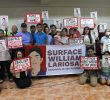
MASSACRE SITE. Erita Capion, sister-in-law of Juvy Capion, presents to the Benedictine nuns the details of the “Tampakan Massacre” Sunday during a forum at St. Scholastica College in Manila. Juvy Capion and her two young sons were “massacred” by the 27th Infantry Battalion last October. (davaotoday.com photo by Alex D. Lopez)
DAVAO CITY— Swiss mining giant Glencore will go on trial before the United Nations Human Rights Council (UNHCR) in Geneva this month for “troubling human rights violations in the Philippines.”
The UN rights tribunal, in its report released June 23, identified eight transnational corporations, including Glencore, for corporate violations committed around the world.
According to Alyansa Tigil Mina (ATM), the UNHRC voted on last June 23 a resolution “to initiate the process to create an international legally binding instrument that will hold transnational corporations (TNCs) such as Glencore accountable for corporate human rights abuses.”
Fr. Joy Pelino, director of the Social Action Center of the Catholic Diocese of Marbel, also in a statement said “Glencore/Xstrata’s (GX) activities in Tampakan has committed numerous human rights violations including the killing of Bla’an leaders and some members of their family who oppose mining activities in the area”.
“They desecrated people’s freedom, dignity and identity.” Pelino said, adding that “Glecore/Xstrata’s monstrosity should be stopped and justice needs to be served now.”
In a phone interview Wednesday, Jaybee Garganera, ATM national coordinator, said “these cases of human rights violations and the marginalization of the Bla’an are a result of the defective Philippine Mining Act of 1995”.
Garganera disclosed his group’s documented “string of human rights violations committed by Glencore/Xstrata’s” as he said that these were already reported to the UNHRC in June 17-19 this year.
Rights abuses against B’laan tribe
In a report also submitted to UNCHR, the Tampakan Forum said there existed a “systemic human rights violations including displacement, lack of consultation, misinformation, threats and harassment against the Bla’an people.”
A documented report it submitted to the UN Special Rapporteur on Indigenous Peoples in 2002 and on April 2012, showed that “Xstrata/SMI had clearly committed human rights violations when its road widening project destroyed crops, and farms and houses were burned”.
“At least four incidents of harassment perpetrated by police and military were documented in the first quarter of 2012.”The report was culled from a fact-finding mission it conducted.
The ATM also reported at least three incidents of extra-judicial killings believed to be directly linked to the Tampakan mining project. It linked the massacre of the Capion family on August 2012 which killed Juvy Capion and her two sons. The military explained the incident away as an “armed encounter”.
In January 2013, B’laan leader Kitari Capion was killed by paramilitary elements, and on October 2013, the highest-ranking leader among the Bla’ans, Anting Freay, was killed by government soldiers.
“All the victims are families and relatives of Daguil Capion, the Bla’an chief entrusted with defending the ancestral lands,” the group said.
Daguil Capion was already forced into hiding before the massacres following warning from the tribe that he was the target of assassination.
“The labeling of Bla’an community rights defenders as “insurgents” and “bandits” or criminals is one way that the state justifies the arrests and attacks on the community,” Garganera pointed out.
“The presence of Philippine Military, Civilian Armed Forces Geographical Units (CAFGU) and KITACO Task Force (Kiblawan/Tampakan/Columbio Task Force), a combination of military and CAFGU which is part of the KITACO Growth Area Project, tasked to augment peace and security and to protect private investments are all heavily deployed within the areas covered by the Tampakan mining project.”
A human rights impact assessment commissioned by a German and Swiss organizations said that the “Tampakan Mining project has significant impacts on the human rights situation in the area.”
“This amounts to a scenario in which a responsibly operated open-pit mine of such large scale does not seem feasible. Philippine government authorities bear the major responsibility for this fragile situation in the Tampakan area,” the report stressed.
The assesssment was done by the Institute for Development and Peace (INEF) in June 2013 for the Misereor (German Catholic Bishops’ Organization for Development Cooperation) and Fastenopfer (Swiss Catholic Lenten Fund). A copy of the report was obtained by Davao Today.
The HRIA report concluded that the Tampakan mining is “embedded in a context which is characterized by a combination of prevailing poverty, a high level of marginalization and discrimination against indigenous groups, especially in terms of basic services, government failure to meet its human rights duties.”
It reported five major drawbacks on the side of the Tampakan mining project: 1.inconsistent information and lack of meaningful participation of the peoples concerned; 2.provision of basic services made dependent on the future of the project 3. imbalanced power relationship between SMI and affected communities; 4. insufficiency of established grievance mechanisms; and 5. accumulating grievances and triggers of violent conflict.
“The report also outlined the significant impacts of the mining project on human rights which linked the volatile peace and high-risk security situation to the mining project; noted the high level of marginalization and discrimination against indigenous peoples; and also noted the government failure to fulfill human rights duties.”
The HRIA report also said that, “(T)aking the standards laid down in international human rights treaties as criteria, it is obvious that the Philippine government is violating its human rights obligations at all three levels of respect, protect and fulfill.
“Furthermore, failures at the different levels intermingle and mutually reinforce each other. They are particularly drastic with regard to the right to life and to economic, social and cultural rights of indigenous communities.”
Glencore/SMI deny rights violations vs. tribal groups
Mr. Charles Watenphul, media officer of Glencore/Xstrata based in Switzerland, in an email to DavaoToday Wednesday said “the proposed Tampakan project has received resolutions of support from 11 B’laan cultural community councils and chieftains representing indigenous people within the project area and immediately adjancent to it. A total of 131 stakeholder groups have signed and presented resolutions of support for the project.”
On the alleged violence and conflict including the killings of indigenous peoples, Glencore/Xstrata through Sagittarius Mines Incorporated said: “SMI does not condone violence in any form. We actively promote and support peaceful approach to conflict resolution that upholds human rights and respects national laws, regulations and international standards.”
“We strongly stand by our commitment to protect and respect the human rights of communities in our project area. In 2008 we adopted the “Volutary Principles on Security and Human Rights” and have continued to implement these across every aspect of our project,” SMI Executive Vice-President Justin Hillier, in an email interview, told DavaoToday.
Support to the IP community
Hillier said: “(W)e have championed inclusive and sustainable socio-economic progress for the region, through responsible minerals development,” adding “SMI has contributed significantly to our host communities through a series of both mandatory and voluntary corporate social investment programs as we have invested almost USD 10 million in initiatives aimed at building social and economic development capacity of local communities.”
The Tampakan project is a copper and gold mine in the south east of the southern Island of Mindanao. Xstrata is the main company behind the project. Its local subsidiary Sagittarius Mining International (SMI) has ploughed $350 million into the $5.9 billion Tampakan project, which it describes as one of the world’s largest undeveloped copper-gold deposits.
The Tampakan project area contains 15 million tons of copper and nearly 18 million ounces of gold, according to SMI/Xstrata. It will generate $7.2 billion in tax and royalty revenue for the government over its 20-year mining life.
The company said it aimed at the beginning operations on the Tampakan project by 2016, but the province, the CBCP and the environment watchdogs are opposed to the project that will have an impact for ages on the people living near the mining site.
Environment protection
Asked on the issue of alleged destruction of forests and rivers, the company claimed that “extensive studies undertaken as part of the EIA found that the majority of the proposed final mining area (9, 600 hectares) was already significantly disturbed by local logging and “kaingin” farming activities.”
The company said that “a Biodiversity Management Plan would be implemented to ensure important flora and fauna species are protected and any impacts minimized.”
The company added that it produced two important environmental reports that were made publicly available, namely: the Environmental Impact Statement (Eis) and Environmental and Social Impact Assessment (Esia).
“The EIS was developed to meet Philippine regulatory requirements and support the project’s application to government for an Environmental compliance certificate. The ESIA was an additional report, developed in partnerships with international experts such as PAE Holmes, Hansen Bailey, among others, to further demonstrate our assessment of potential environmental and social impacts.”
Hillier said “both these reports detail appropriate mitigation strategies to manage environmental and social impacts and will form part of the environmental management plan.”
“We continue to be encouraged by strong support from our host communities, including indigenous cultural communities, local governments, and business and community partners. Our work to date has included years of community engagement, robust dialogue, technical presentations, open-pit mine visits, public consultations and public scoping activities.”
“We are committed to ongoing engagement with our stakeholders in a fair, timely and culturally-appropriate manner, respecting the cultural heritage, customs and rights of local communities,” Hillier said. (davaotoday.com)
blaan, capion, environment, environmentl defenders, GLENCORE, mining, SMI, tampakan, xtrata










